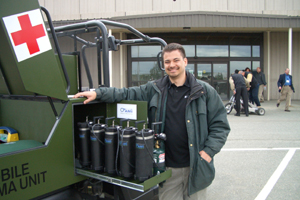FUEL CELL ATV
Fuel Cell technology is a promising option in the
search for feasible alternative energy solutions to our
growing energy crisis. As the technology matures, fuel
cell systems have the potential to be incorporated as a
power provider for emerging electric vehicle propulsion
solutions, but where the technology is today, the fuel
cell appears to be better suited as a battery
replacement technology to provide off-the-grid power in
the place of traditional battery systems or small
gensets.
The Fuel Cell ATV was a project performed in conjunction
with the National Automotive Center to explore the use
of Fuel Cell technology for off-board power
applications. A Kubota all-terrain vehicle was upfitted
by ICRC with a custom carrier hosting an array of
medical equipment that was intended to function as a
mobile trauma unit.
As a trauma response unit, the Fuel Cell ATV was
equipped with all of the supplies a military trauma team
would require. An electronic vital signs monitor,
defibrillator, aspirator and suction pump were
accompanied by combat ready inflatable stretcher and a
first aid kit including an intubation kit and a full set
of bandages. Utilizing a solid oxide fuel cell (SOFC) as
the main power source for the accessory medical
equipment on board, the Fuel Cell ATV was capable of
providing up to 1kW of AC power to support soldier
equipment. The vehicle was also equipped with an onboard
air compressor and a military SINCGARS radio docking
station. Users in the field therefore had enough
equipment to effectively attend to any medical
emergencies and stabilize the victimís condition, while
radioing pertinent location and status information to
facilitate a rescue.
As the program manager and technical lead, I worked
through our government customer to secure funding and
select the appropriate vehicle upfitter to assist with
the metal fabrication we would require as part of the
project. I also performed the necessary technology
assessments to select the appropriate medical and
electronic equipment for the project, including making
the arrangements to select and acquire a prototype fuel
cell that best fit our application. All of the wiring
harnesses, electrical schematics, and installation was
also completed by me while I worked with a local vehicle
upfitter in Wixom, Michigan, RM Corporation, to complete
the build.
Fuel Cell technology has come a long way in the last ten
years and I remain actively engaged in understanding the
latest developments in this emerging technology area.
Over the years, Iíve been called in to support several
other fuel cell integration activities based on my
experience with this technology.



